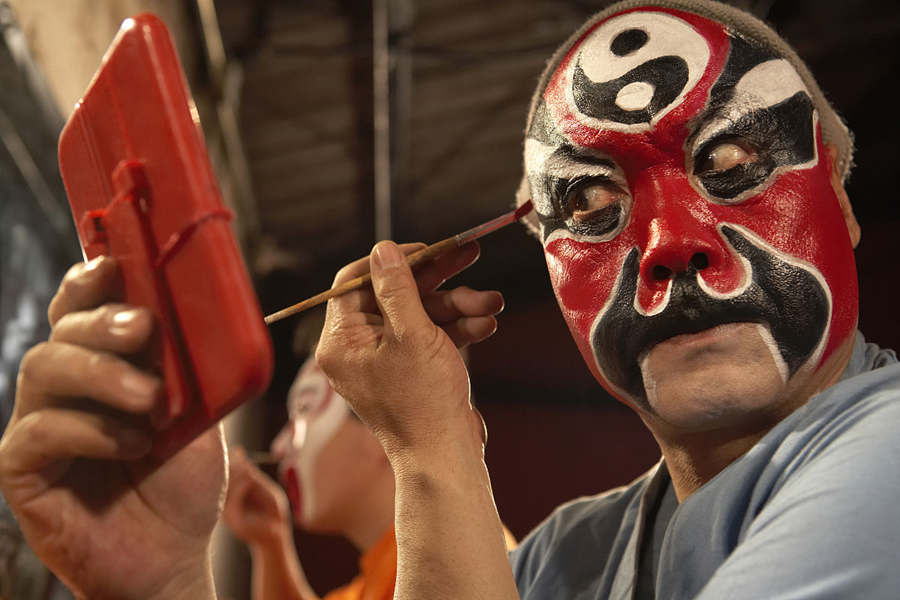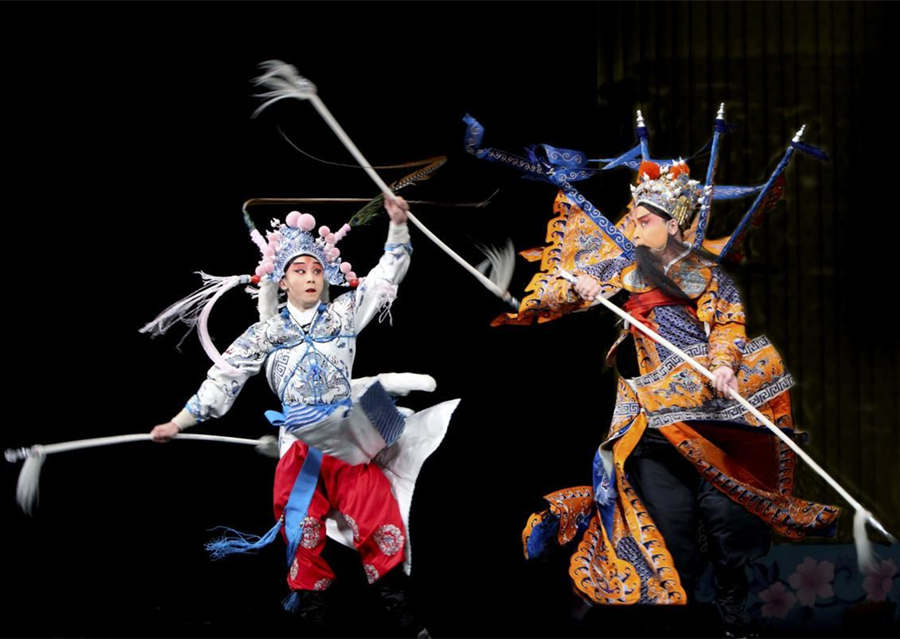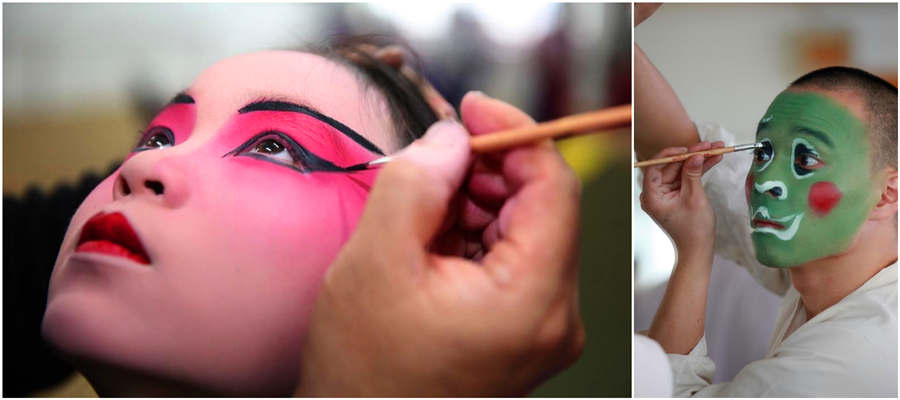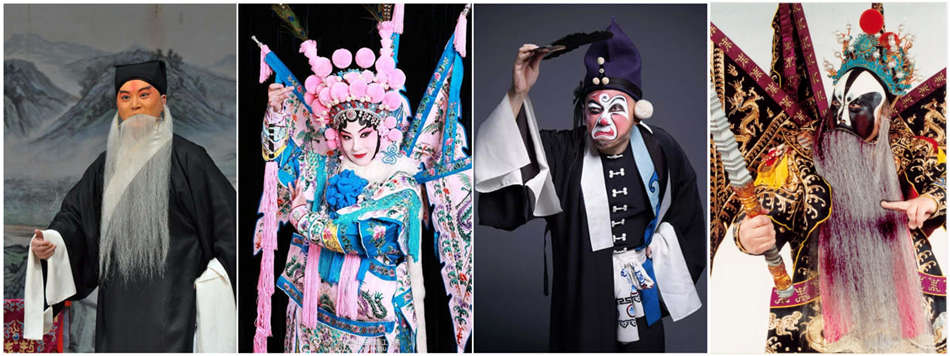Peking Opera
Centered in Beijing and popular all over the country, Peking opera, also known as Ping opera and Beijing opera, is the most influential Chinese opera genre and regarded as the national opera of China. Being endowed with full of Chinese cultural elements, the opera is like an encyclopedia of Chinese culture, presenting the audience a visual and auditory feast of historic stories, dainty backdrop, exquisite costumes, graceful gestures, and acrobatic fights. After 250+ years of development, Peking opera has become one of the traditional cultural treasures in China.
In May 2006, Peking Opera was approved by the State Council to be included in the first batch of national intangible cultural heritage list. In 2010, it was inscribed on the UNESCO Representative List of the Intangible Cultural Heritage of Humanity.

(Peking Opera mask prototype)
Peking Opera History
In 1790, Emperor Qianlong of Qing Dynasty was celebrating his eightieth birthday. Upon the arrangement of a salt tycoon in Yangzhou, the Sanqing Troupe of Auhui Opera headed by the female-role actor Gao Langting went to Beijing to deliver congratulatory performances to the emperor and royal family. For some reason, they didn’t return home after their job had been done, but stayed in Beijing. In the following years, more Anhui opera troupes arrived in Beijing, among which Sanqing, Sixi, Hechun and Chuntai troupes were the most acclaimed at that time.
The convergence of these theatrical performers started a gestation period of Peking Opera, a brand-new opera form in the capital city of the nation. They worked with Han tune artists from Hubei, and blended with Kunqu opera (from Jiangsu) at the same time. Part of the repertoire, tunes and performance skills of Qin Opera (from Shaanxi) have also been absorbed in the new born opera. Through continuous exchange and combination, Peking Opera came into being around 1840 – 1860 as an independent opera form based on the joint efforts of opera performers from all over the country.
Peking Opera Features
Peking opera has a set of standardized artistic expressions in various aspects such as Chiense acrobatics, martial arts, performance, music, literature, and stage art. It is sung and recited using primarily Beijing dialect, and the librettos are composed according to a strict set of rules that prize form and rhyme. They tell stories of history, politics, society and daily life and aspire to inform as they entertain. Performance is characterized by a formulaic and symbolic style with actors and actresses following established choreography for movements of hands, eyes, torsos, and feet. Traditionally, stage settings and props are kept to a minimum.

(Peking Opera stage show)
Peking opera is featured by flamboyant costumes and recognizable character-identifying makeup. These conventions of Chinese opera are similar to those of 18th-century European traditions, though the sounds are certainly quite different. The need to communicate in music or in theatre requires the repeated use of aural and visual conventions if an audience is to understand and be moved by the event.
Peking Opera Makeup & Painted Faces
The masks and painted faceare part of the Peking Opera art form. Different Peking Opera masks imply different characters and personalities. A red face indicates commendatory, loyalty and courage. Black face indicates neutral, fierceness and wisdom. Blue and green faces also indicate neutral, yet representing the heroes of the jungle. Yellow mask and white mask have derogatory meanings, representing the fierce and vicious people. The golden and silver faces are mysterious, representing the gods and demons.

Peking Opera Music & Musical Instruments
The melodies of Peking Opera can be divided into the Xipi and Erhuang styles, which came from Anhui and Hubei province originally. Arias, fixed-tune melodies and percussion patterns are included in the opera music. The music of Peking opera plays a key role in setting the pace of the show, creating a particular atmosphere, shaping the characters, and guiding the progress of the stories. ‘Civilian plays’ emphasize string and wind instruments such as the thin, high-pitched Jinghu and the flute Dizi, while ‘military plays’ feature percussion instruments like the Bangu or Daluo.

(The main Peking Opera musical instruments)
Peking Opera Characters & Roles
The roles of Peking Opera are classified into Sheng, Dan, Jing, Chou, etc. Each profession has a fixed set of performance programs, and the skills of singing, thinking, and fighting have their own characteristics. There are about 1,300-1400 traditional repertoires, and more than 300 or 400 are often performed.
■ Sheng – Male role: Sheng has some sub-categories, including Senior (Lao Sheng), Middle-Aged with beards (Xu Sheng), Junior (Xiao Sheng), Acrobatic (Wu Sheng). These are classified according to the role’s characteristics.
■ Dan – Female role: There are six main parts which principally indicate different female roles: Qing Yi, a modest and virtuous lady; Hua Dan, a vivacious maiden; Gui Men Dan, a young girl; Dao Ma Dan (Peking Opera blues), a strong, more powerful character, usually a woman general; Wu Dan, the female acrobatic; Lao Dan, a senior woman.

(The main Peking Characters: Sheng, peking Opera blues, Chou and Jing)
■ Jing – Painted face male: This part is more featured with his aggressiveness, courage and resourcefulness. Often playing the part of a high rank army general, the Jing actor with his painted face can also be seen as a warrior or official. The exaggeratedly-painted face with a robust, husky, bass voice makes the role easily identified by audience. Whether brave, loyal or treacherous, merely one glance on the face makeup of a jing is enough for an experienced fan of Peking Opera to know his true nature and character.
■ Chou – The comedy role: the comedy actor/actress who usually plays the minor role in the drama, a likeable and amusing character with blinking eyes and funny gestures. The part can be easily recognized by a white patch painted on the nose and the area between two eyes.
More about Chinese Opera: